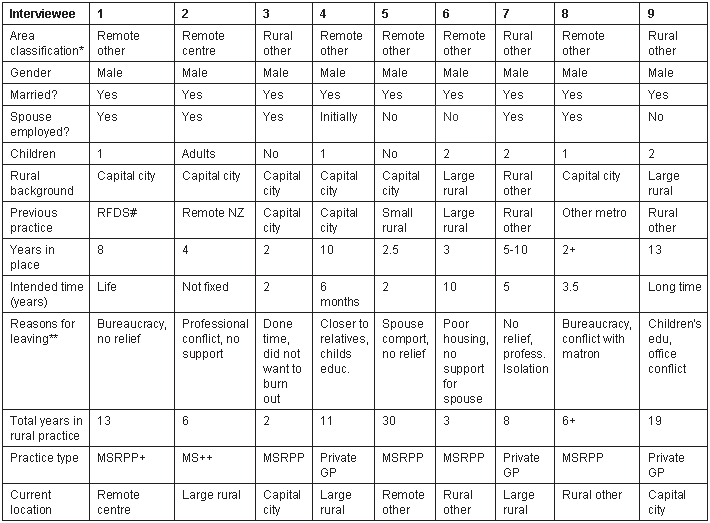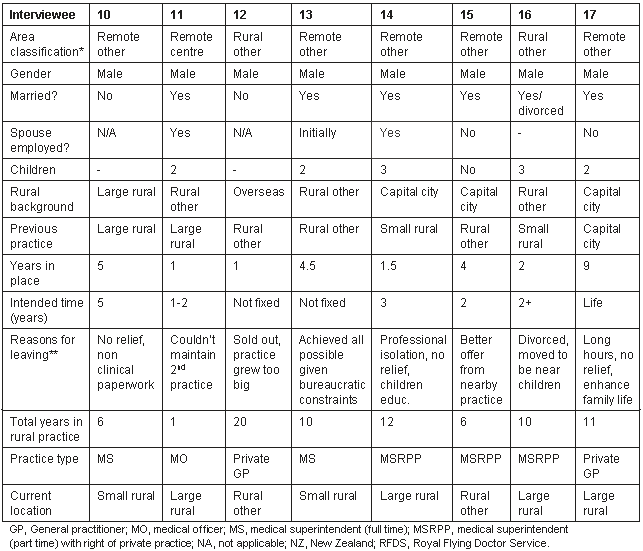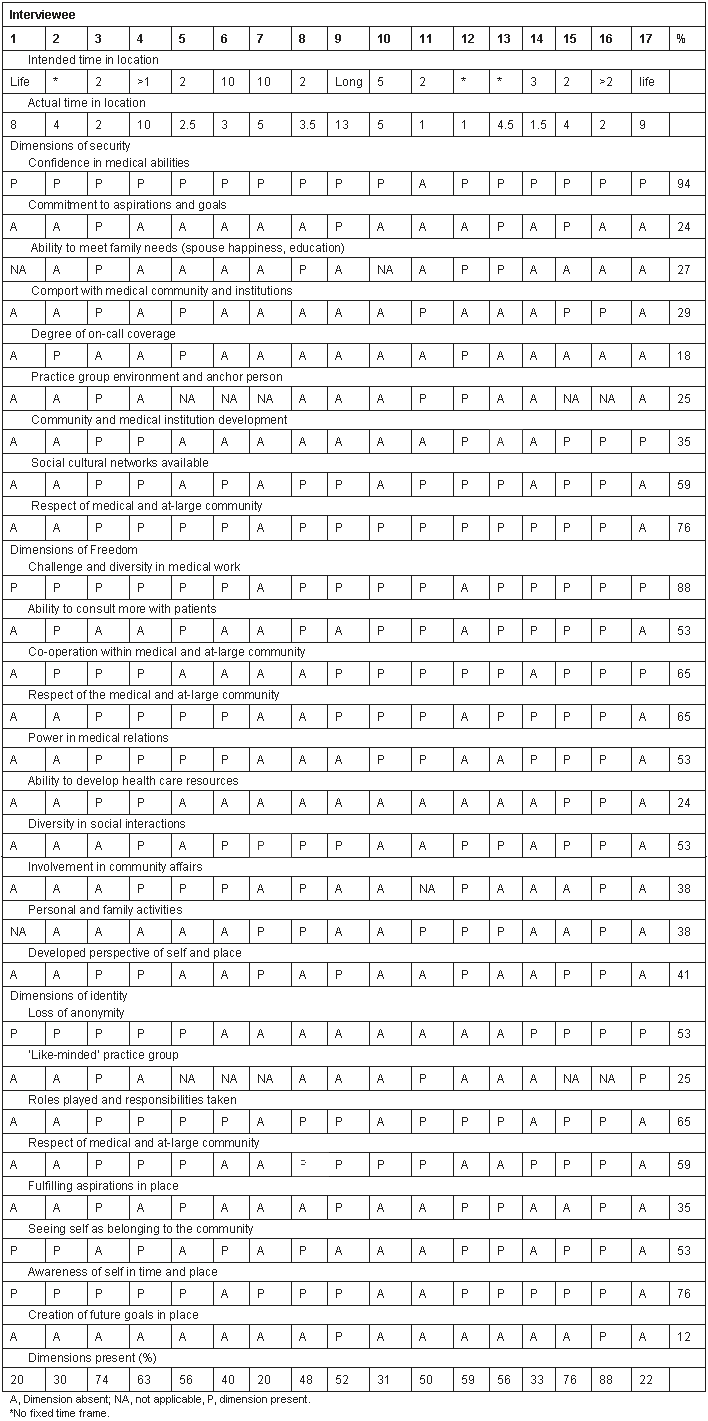Until recently, the focus on the universal problem of insufficient medical practitioners in rural areas had been on training and recruitment1-5. The issue of retention of rural practitioners was often seen as a simple extension of the recruitment issue and the primary cause of the workforce problems was thought to be insufficient numbers of graduates entering rural practice6-9. Hence, many of the rural workforce strategies in Australia targeted selection of medical students, medical curricula, postgraduate training and retraining experienced urban graduates10. Many of these are long-term strategies. To date, there is little consistent evidence that the rural workforce situation in Australia is improving11.
However, there has been increasing recognition in the literature that retention involves a different set of issues from recruitment12-15. This is because decisions to take up rural practice are made outside of the contextual setting of rural practice, whereas decisions to remain occur within that setting and are based on experience there16-18. The decision to remain in rural practice appears to be a dynamic equilibrium of positive and negative factors, and issues such as overwork and poor adaptation to role changes easily upset this equilibrium15. Many of the triggers could be addressed at a policy level, potentially improving retention. Therefore, there is a need to understand better the issues that influence retention, particularly those that can inform policy.
A study of long-standing rural physicians in eastern Kentucky demonstrated a relationship between integration and rural physician retention16. The author argued that integration into a community was a key element in retention, and that the process of integration is a 'type of progress that builds bonds with place ... that in turn encourage retention'16 (p.28). That said, integration and retention can be challenged by 'various contingencies of life that more or less require us to change locations'16 (p.28). The resulting model of integration is an active developmental process based on three 'principles' - security, freedom and identity - which together form the basis of practitioner retention. A series of 'dimensions' exists within each of these principles (these dimensions form the basis of Table 2).
Our experience of rural practice suggested that many aspects of the US-based model appeared relevant to the Australian setting. We therefore decided to review (post facto) transcribed in-depth interviews with former rural practitioners (Table 1), in Queensland Australia, as a first step in developing a prospective longitudinal study of newly recruited rural practitioners. In this paper, we use the model of integration to analyse the interview transcripts in an effort to identify consistent patterns of presence or absence of the dimensions and to guide future research activities. This is a scoping study rather than a critical analysis of the data. It was undertaken to assess the worthiness of undertaking a larger scale prospective study focusing on the three principles and their associated dimensions.
Rationale and interpretation of principles
Many of the 27 dimensions can be considered to be universal indicators; eg 'confidence in medical abilities'; 'career aspirations and goals'; 'desire to meet family needs'; 'on-call coverage'; 'social and cultural requirements'; and respect for, and of, the medical and at-large communities.
However, other dimensions are probably more system specific. As a specific example, the security dimension 'comfort with medical community and institutions' operates at two distinct levels in the Queensland setting. Firstly, at the local level, the medical community is usually quite small - commonly less than a handful of medical practitioners and not many more nursing and allied health professionals. Secondly, at the broader institutional level, the state-based public health system is a key provider of health services in rural and remote Queensland. Despite several restructurings during the past decade, ostensibly to give more local level autonomy, the system remains largely under the control and direction of the Head Office in the State capital (Brisbane). For private practitioners, the broader institution is the national universal health insurance scheme (Medicare), which either directly (through payments to the practitioner, called direct-billing), or indirectly (through reimbursements to the patient) accounts for a considerable proportion of general practitioners' income. Medicare pays 85% of the 'scheduled fee' that is determined and agreed by the Health Insurance Commission and medical practitioner organizations. The remainder of whatever fee a practitioner charges is met by the patient, unless the practitioner direct-bills Medicare. One way, or another, most rural medical practitioners have to deal with the state-based public system - many as employees, others as referral agents to hospitals. In some small communities, the same practitioner (Medical Superintendent with Right to Private Practice [MSRPP]) fulfils both the public and private roles19. These and associated issues limit the role that Queensland practitioners can play in medical institution, health care resources and community development (ie 'community & medical institution development' and 'ability to develop health care resources' dimensions).
Methods
The data used here were originally collected for an in-depth survey of practitioners' reasons for leaving rural practice. While in-depth, the interviews were reasonably open (ie semi-structured) in terms of the topics covered.
Cutchin's model of experiential integration was used as the basis of the post facto review of the transcripts (Table 2). Our experience of rural practitioner retention suggested that the model provided a reasonable summary of the types of issues raised by rural practitioners and therefore was a worthy starting point to explore the reported experiences of former rural practitioners.
In reviewing the individual transcripts, we assessed whether each dimension was raised either positively (present) or negatively (absent) and, in the event that no mention of a dimension was made, it was also coded as absent. Not all dimensions were applicable to all interviewed practitioners (eg 'family' for an unmarried practitioner; and 'group' for a solo practitioner). Comparisons were made between each practitioner's early expectations and their later experiences in order to determine the strength and direction of the evidence for each dimension and in an attempt to nullify purely negative responses relating to the time of departure.
Results and Discussion
Table 1 summarises the key characteristics of interviewees. The Rural Remote & Metropolitan Areas Classification (RRMA) was used to code both the sites where practitioners had previously worked and were currently working. The majority of interviewees were males, married and from metropolitan backgrounds, although seven of the 17 had lived in rural communities for all or most of their childhood. Interviewees had been in a wide variety of practice styles, including full-time Medical Superintendents of rural hospitals (MS), part-time Medical Superintendents with Right of Private Practice (MSRPP) and full-time private practitioners. Most had been in communities ranging from 1000 to around 10 000 people. All, but one (a hospital-based general physician) were general practitioners and most had entered rural practice with some timeframe regarding how long they would remain in rural practice in mind. Three had no particular timeframe in mind, but had intended to stay indefinitely if they liked rural practice. Six of the 14 with a predetermined timeframe left before they had anticipated and three stayed longer than anticipated. Ten interviewees had prior knowledge and experience of life in their chosen community (a major reason for choosing that community), usually as a relieving practitioner. The majority of interviewees relocated to other rural settings - generally larger communities closer to the coast and southwards towards Brisbane (Queensland State capital). All remained positive about rural practice and, for the most part, the communities they had left.
Table 1: Personal characteristics of participants

Table 1 continued

Table 2 summarises the presence/absence of the 27 dimensions in each of the transcripts. Six dimensions (2, 5, 6, 15, 21, 27) were evident in no more than one-quarter of interviewees. A further seven dimensions (3, 4, 7, 17, 18, 19, 24) were exhibited by fewer than half of the interviewees. Just four dimensions (1, 9, 10, 26 - often noted by interviewees as key attractors to rural practice) were exhibited in more than 70% of cases. In terms of the three principles; only three (of 9) Security dimensions, six (of 10) Freedom dimensions; and five (of 8) Identity dimensions were evident in more than 50% of cases. It is important to remember that absence of a dimension may have been due to either a negative comment, or no comment at all, during the interview. It is thus possible that the absence of dimensions may be over-estimated. We, therefore, have been cautious in our interpretation of the results, focusing more on broad trends than on specific issues, in line with our aim of assessing the potential for a dedicated prospective study.
Table 2: Evidence of experiential place integrated dimensions

Some dimensions are not easy to fulfill (or identify) in the Queensland setting, because the state public health system is a major provider of health services in rural and remote areas. For example, practitioners employed by the state (MS and MSRPP) are quite limited in what they can achieve in terms of institutional development (dimension 7), or developing health care resources (dimension 15). That said, several interviewees noted that their local area health managers were quite pragmatic about the allocation and use of resources.
Because many Queensland rural and remote towns are relatively small (generally 1000-3000 people), the health infrastructure and associated medical communities are small - typically a small hospital of not more than 30-40 beds and one or two practitioners. The larger communities (5000-10 000) have commensurately larger facilities and medical communities (perhaps 4-6 practitioners). It is therefore difficult to assess 'comfort' with medical community and institutions (dimensions 4, 9, 12, 13, 23), for example, except for the larger communities. Conversely, the majority of interviews contained evidence that small communities and practitioner networks positively influenced 'respect' (9, 13, 23) and 'loss of anonymity'20. 'Respect' was high because of the close relationships that local practitioners developed with their communities and each other. The anonymity that was a feature of urban life evaporated for most rural practitioners.
The most sobering pattern in this analysis is the generally low presence of Security dimensions (1-9), particularly those related to professional issues. It is perhaps not surprising that many of these dimensions are absent in interviews of practitioners who have left rural practice. However, of greater import is the fact that practitioners commonly made negative comments with regard to the Security dimensions.
- For example: The health authority's orientation to priorities, to me, seemed rather strange. When you tried to get something up and running, there would be 45 committees to look at it. They're 250 km away and can't remember your name, yet they think they can make a better decision than we could, there on the ground. ... They were more worried about what the politicians wanted than they were about service delivery. (Dimensions 4, 7, 9)
There was a lot of problems with health delivery in the district. ... But every time you brought up a problem, it was largely ignored. ... Basically, I couldn't see where anything was going to change. (Dimensions 2, 4, 7, 9)
Paperwork requirements continually increased, without explanation or obvious reason. Requests for additional information would come through on the fax, often with a requirement for immediate response. Then there was accreditation! (Dimensions 4, 9)
You are on call for the hospital for the whole time ... It takes its toll ... you don't get the chance to unwind and relax ... To some degree burn-out was a factor. (Dimension 5)
I think the pressure really began when we started boarding our children. ... that became a huge strain on the family, that was the beginning of the end there. (Dimensions 3, 8)
Compared with the rates for dimensions in the Freedom and Identity principles, loss of security (at least in terms of the listed dimensions) might well be the major reason for practitioners moving on. Perhaps, a loss of security is the final straw that causes practitioners to leave. A noteworthy feature in this respect was the quite low numbers of dimensions present in the interviews with five of the six practitioners (1, 6, 7, 14, 17) who did not see out their planned time.
By contrast, those practitioners with the highest numbers of dimensions present often left because of some external 'pulling' factor rather than some factor related to the location. For example, Interviewee 16 moved to be closer to his children, Interviewee 15 received a better offer from his previous principal (but only moved to the next community), Interviewee 3 held to his original plan, achieved much, enjoyed his time, but sensibly refused to burn-out in place. At the other end of the scale, interviewees demonstrating low numbers of dimensions often cited internal 'pushing factors'. For example, Interviewees 1 and 10 grew tired of the bureaucratic demands and lack of relief, Interviewee 2 left because of conflict with a colleague. That said, some better established practitioners (eg 8 and 9) were also subject to 'pushing factors', perhaps as the last straw in an already deteriorating situation.
Conclusion
The results suggest that a dedicated prospective study focusing on the three principles and their associated dimensions is warranted. In view of the high costs associated with a dedicated prospective study that would involve interviews before, during and after leaving rural practice, there is a need to establish a database over time in order to monitor all dimensions. If loss of security could be demonstrated to be a feature amongst those who leave rural practice, there would be a case for targeting policy or support initiatives at maintaining security for rural practitioners. Although considerable efforts are being made to provide practitioners with more relief for annual and sick leave and continuing medical education, on-call coverage remains a widespread problem. Perhaps it is time to take a radical approach to on-call coverage, rather than tinkering around the margins.
References
1. DeFriese GH. Ricketts TC. Primary health care in rural areas: an agenda for research. Health Services Research 1989; 23: 931-974.
2. Kamien M. Buttfield I. Some solutions to the shortage of general practitioners in rural Australia: Part 1. Medical Journal of Australia 1990; 153: 105-107.
3. Strasser R. How can we attract more doctors to the country? Australian Journal of Rural Health 1992; 1: 39-44.
4. Craig ML. Jackel CA. Gerrits PB. Selection of medical students and the maldistribution of the medical workforce in Queensland, Australia. Australian Journal of Rural Health 1993; 2: 17-21.
5. Kazanjian A. Pagliccia N. Key factors in physicians' choice of practice location: findings from a survey of practitioners and their spouses. Health and Place 1996; 2: 27-34.
6. Horner R. Samsa G. Ricketts TC. Preliminary evidence on retention rates of primary care physicians in rural and urban areas. Medical Care 1993; 31: 640-648.
7. Pathman DE. Konrad T. Ricketts TC. The comparative retention of National Health Service Corps and other rural physicians: results of a 9-year follow-up study. Journal of the American Medical Association 1992; 268: 1552-1558.
8. Wise AL. Hays RB. Adkins PB. et al. Training for rural general practice. Medical Journal of Australia 1994; 161: 314-318.
9. Baldwin LM. Hart G., West PA., Norris TE. Gore E. Schneeweiss R. Two decades of experience in the University of Washington Family Medicine Residency Network: practice differences between graduates in rural and urban locations. Journal of Rural Health 1995; 11 60-72.
10. Holub L. Williams B. The General Practice Rural Incentives Program: development and implementation. Australian Journal of Rural Health 1996; 2 117-127.
11. AMWAC (Australian Medical Workforce Advisory Committee). Report on Australia's Medical Workforce, Australian Government Publishing Service, Canberra, 1996.
12. Pathman DE., Konrad T. Agnew C. Studying the retention of rural physicians. Journal of Rural Health 1994; 10: 183-192.
13. Cutchin MP. Norton JC. Quan MM. Bolt D. Hughes S. Lindenman B. To stay or not to stay: issues in rural primary care physician retention in Eastern Kentucky. Journal of Rural Health 1994; 10: 273-278.
14. Forti EM. Martin KE. Jones RL. Herman JM. Factors influencing retention of rural Pennsylvania family physicians. Journal of the American Board of Family Practice 1995; 8: 469-474.
15. Hays RB. Veitch PC. Crossland LJ. Cheers B. Why doctors leave rural practice. Australian Journal of Rural Health 1997; 5; 198-203.
16. Cutchin MP. Physician retention in rural communities: the perspective of experiential place integration. Health and Place 1997; 3: 25-41.
17. Cutchin MP. Community and self: concepts for rural physician integration and retention. Social Science and Medicine1997; 44: 1661-1674.
18. Kamien M. Staying in or leaving rural practice: 1996 outcomes of rural doctors' 1986 intentions. Medical Journal of Australia 1998; 169: 318-321.
19. Sondergeld S. Nichols A. Medical superintendents with right of private practice in Queensland: practice, training and support. Australian Journal of Rural Health 1997; 5: 11-16.
20. DHSH - Department of Human Services and Health. Rural, Remote and Metropolitan Areas Classification: 1991 Census Edition. Canberra: Australian Government Publishing Service, 1994.
Published 5 April 2002; modified 7 August 2003.
